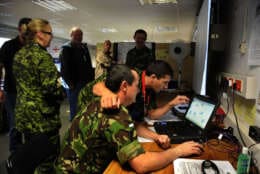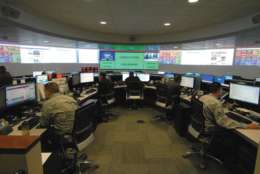General Dynamics Information Technology
-
Dave Vennergrund is director of the data and analytics practice at General Dynamics Information Technology. He recently joined Federal News Radio to discuss the impact and importance of data and analytics in government.
August 02, 2018 -
During Cloud Month, read about why a federal transition to the technology has to be approached from a holistic perspective.
June 01, 2018 -
The Pentagon's chief information officer's office spearheaded the development of the ITSA tool as part of its data center consolidation effort.
May 08, 2018 -
John Hale, DISA’s chief of enterprise applications, said his office is helping the military services and agencies do the hard work before moving to the cloud.
April 30, 2018 -
Perhaps the first generation of managed services was ahead of its time. No more. Given the rapid maturation of cloud-hosted applications, more ubiquitous bandwidth, and the greater need to manage costs, more federal agencies are engaging with contractors for managed services.
April 30, 2018 -
Stanley Tyliszczak, staff vice president for Technology Integration and chief engineer within General Dynamics Information Technology’s Chief Technology Office, discusses IT modernization and strategies to meet the evolving IT needs in the federal market. February 20, 2018
February 15, 2018 -
Global aerospace and defense giant General Dynamics announced Monday that it entered into an agreement to acquire the IT company CSRA.
February 12, 2018 -
Women of Washington hosts Aileen Black and Gigi Schumm interview the finalists and winners of the 2016 Women in Technology leadership awards.
May 25, 2016 During 14 years of war in the Middle East, Marines and soldiers came to rely on having ready access to computers. And the more capability they had, the more they wanted. Fuel trucks became targets for insurgents, and defending them became an extra burden for troops. Clearly, a more efficient solution was needed.
March 07, 2016Cybercrime costs the U.S. economy some $100 billion a year, according to the Center for Strategic and International Studies. And the threats only grow more intense, while at the same time, regulatory and compliance issues grow more complex. Government agencies and corporations face the same challenge: How to manage those security risks without breaking the bank.
February 26, 2016-
Over the next three years, the military will deploy a series of sophisticated gateways to better protect its vast network from external attack, according to Army Col. Scott Jackson, who oversees construction of the Joint Informational Environment or JIE.
February 19, 2016 -
According to U.S. Customs and Border Protection (CBP), it takes about 20 seconds to identify and verify each person’s identity using government databases to determine whether or not the individual is on a watch list or unwelcome on U.S. soil for any reason. That’s not fast enough.
February 05, 2016 -
The Federal government’s security clearance system is outdated and needs to be replaced, but fixing it is going to take time because the government is still years away from fully developing a continuous evaluation process that can replace today’s once-every-five-years investigations.
January 29, 2016 What happens when you bring together some of the nation’s leading hackers, the Pentagon’s chief of training and an Air Force Academy professor who teaches cyber skills to cadets? They all agree on one thing: The government’s approach to cyber security is coming up short.
January 15, 2016The intelligence community and private industry are pooling their efforts to fight rising threats to national cybersecurity.
August 26, 2015











